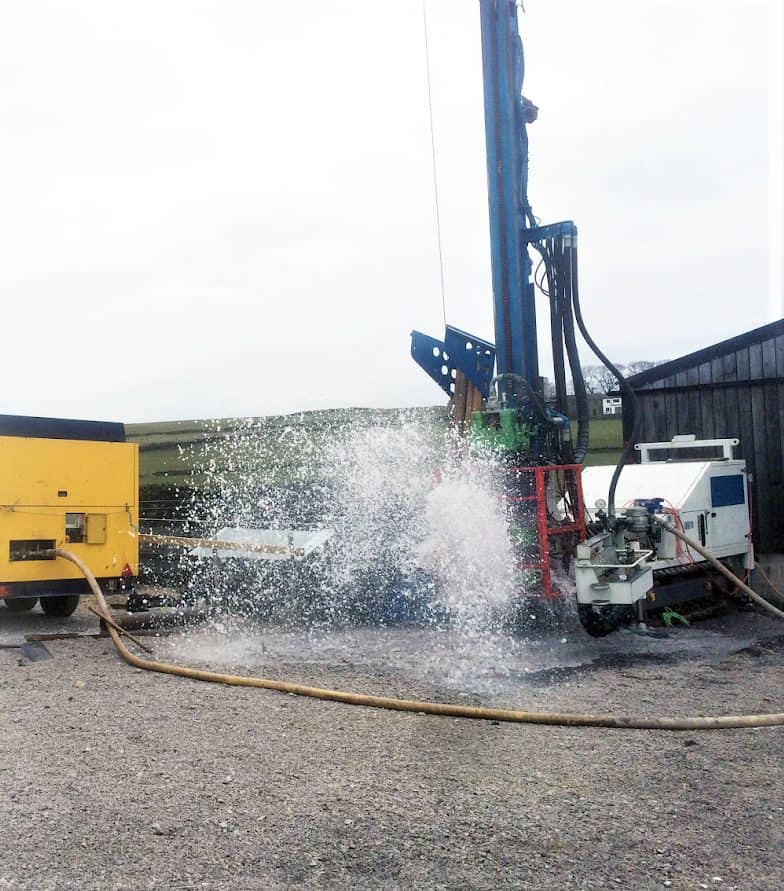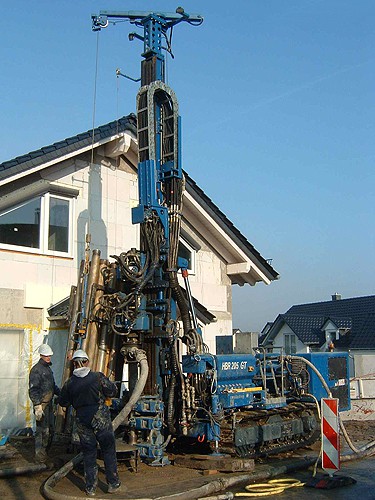Not only do we install water boreholes for private water supplies, but Teckna Group also provides dedicated ground source heat pump drilling services for private heating supplies.
We cover all aspects of ground source heat projects with our specialist equipment, all the way from the installation of geothermal boreholes to the connection of pipework and manifolds.
In order to give our valued customers the most complete service possible, we also provide specialised thermal response tests for borehole array installation.
We undertake many single or multi-borehole geothermal bore drilling projects across the UK, working with both private and domestic clients.
Drilling Geothermal Boreholes
Our industry expertise allows Teckna Group to offer top-quality services to anyone who requires them. To ensure that our practice is always held in the highest regard, we only work with the best equipment suppliers out there. This includes MCS GSHP partners (quality-assured through the Microgeneration Certification Scheme) for full turnkey ground source heat pump packages.
To offer the best choice of system for your bespoke geothermal borehole drilling project, we utilise the most effective equipment in the UK to reach the desired outcome. This includes the use of Dimplex, Vaillant, Worcester Bosch, Steibel, Eltron, Kensa, or NIBE heat pumps to suit project specifications.
Our Geothermal Borehole Systems
At Teckna Group, we work with specialist geothermal and water hydrologist teams to offer geological surveys, ranging from basic heat assessments to complex ground modelling and borehole field design. We can also perform thermal response testing to complement our other geothermal services, which include the installation of ground source heat pump loops.


We install quality-certified loops and connecting pipework using electro-fused couplers. All of our durable borehole loops, geothermal pipework, and fittings are made with PE100+ polymers to ensure compliance with the Vertical Borehole Standards (2011) for professional installation. Pipework can be pressure-tested, sanitised, and flushed before the final addition of heat transfer fluid.
Upon completion of a geothermal borehole, we pressure-test the ground source loop to certify its integrity and to ensure that the grouting process is effective.
The GSHP grouting fills the hole to seal it off from groundwater and guarantee contact between the pipes and surrounding earth for optimal heat transfer. We issue certification of our tests to every client, evidencing our thorough care and attention to detail during your GSHP borehole drilling project.
Contact Teckna Group Today
Local geological conditions permitting, almost anybody with the available external space can install a geothermal borehole, even many older and non-rural properties. At the surface, you’ll only see the borehole cover, but this system can add value to your property and save money on heating bills. The larger the property, the more boreholes will be required to effectively heat the whole building.
If you would like to find out more about our extensive geothermal bore drilling services, be sure to get in touch with our expert team. Call us on 01257 421 700 and we will gladly talk you through what we do, and how you can benefit from our industry-leading skills. You can also fill out the contact form to the left or send an email directly to enquiries@tecknagroup.co.uk with detailed queries.
Geothermal Borehole FAQs
Do I need permission for geothermal borehole drilling?
Usually, you do not need planning permission for GSHP boreholes.
Just like water boreholes, they are considered a ‘permitted development’ when installed on private property for domestic use. That said, there are sometimes restrictions on drilling in certain locations by the Environment Agency or local authorities, so each site must be assessed on an individual basis.
Boreholes of any kind may not be permitted for places within conservation areas, sites of special scientific interest (SSSI), or national parks due to preservation efforts. Otherwise, you should not need permissions or licences to install a ground source heat pump on your domestic property.
However, if you intend to install a GSHP borehole on a non-domestic site, you can only have one without requiring planning permission, and the excavation site must not exceed half a hectare (about 1.2 acres). You must also sign a written agreement with the local planning authority to remove the pumps and restore the ground to its previous condition if they are no longer needed.
Where can geothermal drilling take place?
The beauty of the geothermal borehole drilling process is that it can be carried out almost anywhere. No matter if you want a ground source pump in your garden to heat your home or somewhere on your premises as an industrial business owner, it’s likely that we can install a geothermal borehole for you without a problem.
Of course, borehole drilling projects require in-depth research and planning to ensure that your plot is the most effective location. When our experts visit your facilities, they can quickly evaluate the area and pursue further tests and planning requirements on your behalf. This will help you to decide whether to proceed and determine the perfect spot to drill a geothermal borehole.
As long as there is enough space to work with, your GSHP borehole drilling project should get the green light. We’ll need to assess the heat saturation of the ground and calculate how large the system would need to be to heat the required square footage, as well as considering which type of ground source loop would be most practical given the external space (vertical or horizontal).
If you’re unsure whether your site is suitable for a borehole or not, it’s best to leave it to the experts – Teckna Group can use our vast experience to evaluate your site and make the appropriate judgements. We’ll always do our best to assist you in achieving your requirements.
How deep do geothermal boreholes go?
The depth of a geothermal borehole depends on the site, including the available space and the square footage that the system needs to heat/cool, and the type of ground source heat loop. For example, horizontal loops are relatively shallow, installed about 1.2m below the ground. They also cover a greater area of land, requiring at least 400-600m per maximum loop length.
On the other hand, vertical GHSP boreholes go deeper and take up less horizontal space. They can be 100-200m deep (around 330-650ft), but vertical borehole drilling usually only goes around 250-450ft underground. If you want to convert an existing water borehole, this will probably not be deep enough, requiring further drilling and construction work to be suitable for a geothermal loop.
Since the maximum depth and appropriate loop sizes vary from project to project, we must carry out initial assessments to evaluate the efficiency of geothermal drilling in the specific area. We will then discuss the drilling possibilities to determine whether this will suit your needs, before any decisions are made or any further work is performed.
How much does it cost to drill a geothermal borehole?
The cost of geothermal borehole drilling and ground source heat pump installation is proportional to the depth, materials, and overall size and heating capacity of the specific system. This is why it’s necessary to carry out a geothermal survey to assess the thermal properties of the ground before doing any drilling, which can determine whether the investment would be worthwhile or not.
The larger the system, and the more excavation required to install it, the higher the costs will be. Similarly, the larger the output and the more properties it powers, the lower the installation and operational costs for each household. Ground source heat pumps are extremely energy efficient, producing several times more energy than the pump requires to run.
This means you could drastically reduce your mains fuel bills, eventually paying off the initial investment costs over time. You’ll also lower your carbon emissions, potentially making you eligible for the UK government’s Renewable Heat Incentive (RHI) scheme. You could receive RHI payments totalling a few thousand pounds per year, based on the amount of ‘green’ energy you generate.
How long do geothermal boreholes last?
Ground source heat pump loops are incredibly durable, with lifespans ranging from 20 to 50 years or more – some can even last for up to 100 years! This is far more long-lasting than your standard boiler. At Teckna Group, we remain in touch with many of our clients, who often report that their GSHP systems are still working just as well as they were when we first installed them.
Of course, we want your geothermal borehole to last for many years and perform well in even the harshest of conditions, ensuring that you get the most out of your investment. Many of the boreholes that the Teckna Group team has installed have lasted for over 40 years, so you can be confident in the quality of our output and trust in our high-performance borehole solutions.
Such installations require very little maintenance, and the robust corrosion-resistant materials should hold up for decades to come. Loops should still be inspected at least once every few years to make sure they’re still working efficiently, and to change the heat transfer fluid if needed.
As long as the work is carried out by a professional, like Teckna Group, using high-quality materials, the assembly should remain in proper service for a long time to come. Mechanical works on the site should be avoided, to prevent damage to the piping or potential exposure to sunlight that could speed up the degradation of the plastics.
What is a ground source heat pump (GSHP)?
GSHP systems are based on the principles of heat exchange. Solar energy (from the sun) heats the Earth and is absorbed into the upper layers of the ground. The purpose of a ground source heat pump is to collect the accumulated heat from the soil and rock and transfer it to the desired area – it can also draw the heat away to cool the area if required.
To achieve this, the ground is excavated to allow borehole drilling to a suitable depth, and the heat pump and closed loop piping is inserted. Gaps between the pipes, pump, and borehole walls are then filled with a special type of grout, which forms a waterproof protective seal while conducting heat between the earth and GSHP system.
A ‘heat transfer fluid’ within the pipes absorbs the thermal energy and is pumped around the loop to carry the heat to where you want it to be. Ground source heat pumps can be used for water heating systems or air conditioning systems as an eco-friendly alternative to fossil fuel energy. The efficiency of such a system depends heavily on the local geological properties.
What is geothermal energy?
There may be some confusion over geothermal energy and ground source heat. While these terms are often used interchangeably, ground source heat is one specific type of geothermal energy. When scientists refer to geothermal energy, they’re usually talking about heat stored in the rock deep beneath the Earth’s surface, which comes from the Earth’s core below.
Ground source heat, on the other hand, comes from the sun above. Solar energy is absorbed and stored in the ground, but at comparatively superficial depths, making this a shallow type of geothermal energy. It’s possible to drill extremely deep geothermal boreholes to seek high-pressured steam or hot water, but this isn’t always practical or financially viable.
Either way, geothermal systems such as GSHP boreholes are an attractive option for self-sufficient and environmentally-friendly energy production. Lower layers of the ground maintain a stable temperature throughout most of the year, making it a sustainable and cost-effective method. As geothermal technology continues to develop, the future of these heat transfer systems is bright.














